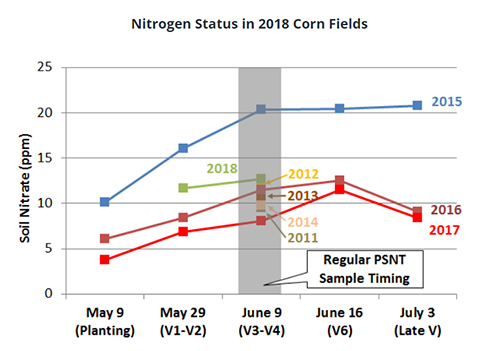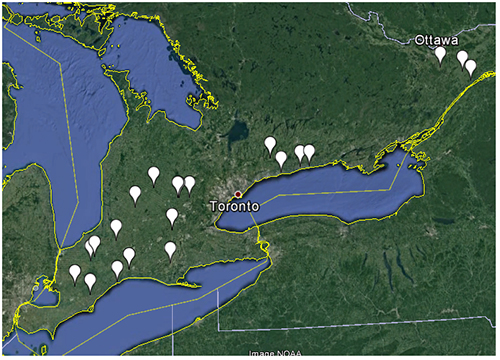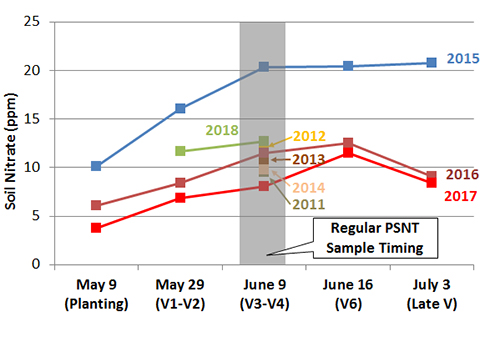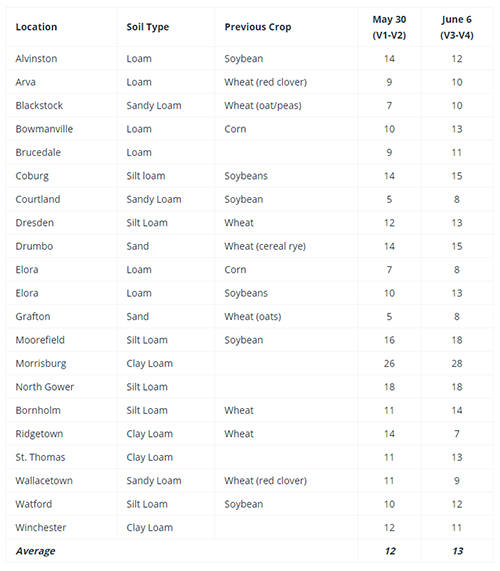
Co-authored with Ian McDonald
Background
OMAFRA Field Crop Unit staff have traditionally conducted an annual Pre Sidedress Nitrogen Test (PSNT) survey across Ontario at the beginning of June to measure background soil nitrate levels mineralized from the soil as an indication of year-to-year soil nitrogen status. In past years, 80-100 samples would be collected from corn fields across the province that had not yet received nitrogen.
In 2015, OMAFRA transitioned to reporting the results of a Grain Farmers of Ontario (GFO) supported Soil Nitrogen Sentinel project. The goal of the project was to collect samples over time from several permanent locations to better understand how natural soil nitrate levels change over the spring. Soil organic N mineralizes over time in the spring at different rates due to factors such as temperature, moisture, soil texture and crop rotation.
While the N-Sentinel project was completed in 2017, the soil nitrate survey has continued similar to the N-Sentinel format. Soil samples were collected from 21 locations at the V1-V2 and V3-V4 crop stages, with an additional sampling event planned for the V6 stage. The V3-V4 sample timing coincides with the historical annual PSNT survey, and is the typical stage for collecting PSNT samples.
PSNT Survey
Nitrogen mineralization is favoured by warm soil conditions with adequate soil moisture and aeration. Excess moisture, especially under warm temperatures, can increase the potential for losses through leaching or denitrification. The spring of 2018 arrived slowly and started with very cool temperatures in April, but experienced seasonal to well above seasonal temperatures in May. By June 6, many areas of Ontario were 100 Crop Heat Units or more above the 30 year normal. Rainfall has been variable across the province, with a few areas receiving regular or heavy rainfalls and other areas remaining relatively dry.
A total of 21 locations were established across the province representing a range of previous crops, soil textures and geographic areas of Ontario (Fig 1). Samples were collected from May 28-30 for the V1-V2 target sampling period, and June 6 for the V3-V4 target sampling. Due to variability in rainfall and planting dates, not all fields were necessarily at these stages. In some cases, soil nitrates can decrease between sampling dates. This could be due to losses (leaching or denitrification), crop uptake or just variability in sampling.

Figure 1. Locations of fields with zero nitrogen plots for nitrate sampling.
The overall average for the V3-V4 PSNT sampling in 2018 was 12.7 ppm. This is close to slightly above the long-term average of 12 ppm from the previous 7 surveys (2011-2016, Fig 2), suggesting typical mineralization patterns in 2018. Full location details and sample results are provided in Table 1.

Figure 2. Soil nitrate sampling results for various sample timings, 2011-2018.
Table 1. Field information and soil nitrate data for nitrate sampling locations.

Recommendations
With PSNT soil nitrate values similar to slightly above long-term averages, normal nitrogen practices should be adequate for these sites this year. These values are a relative indication only, and should not be used as a recommendation for nitrogen rates on any given farm. Soil nitrate values are highly influenced by the environment (agronomic practices, local weather). For instance, if you are in an area which has received significantly more rainfall than other parts of the province, you may have also experienced less mineralization or more loss than is reflected in these results. The only way to know soil nitrate concentrations on your own farm is to pull soil nitrates from your own fields.
PSNT Sampling
To collect PSNT samples, collect several 12″ soil samples across a field using a soil probe. Sample parts of fields differently if there is reason to suspect differences in N content (past history, soil type, topography etc.). Take a well-mixed representative sub sample of approximately 1 lb to fill a lab box or bag. Samples should be chilled to prevent further mineralization and sent to a lab as soon as possible.
OMAFRA PSNT recommendations are only calibrated against natural background soil nitrate mineralization, and should not be used where any nitrogen fertilizer has already been applied. A modest amount of N applied with starter (ie. 30 lb-N/ac) is OK provided sampling can be taken mid-row to avoid these bands. Due to differences in N mineralization timing, nitrogen recommendations in corn fields with manure, red clover or alfalfa in the previous year are more accurate when using nitrogen credits from Pub 811, Agronomy Guide for Field Crops.
Source : fieldcropnews